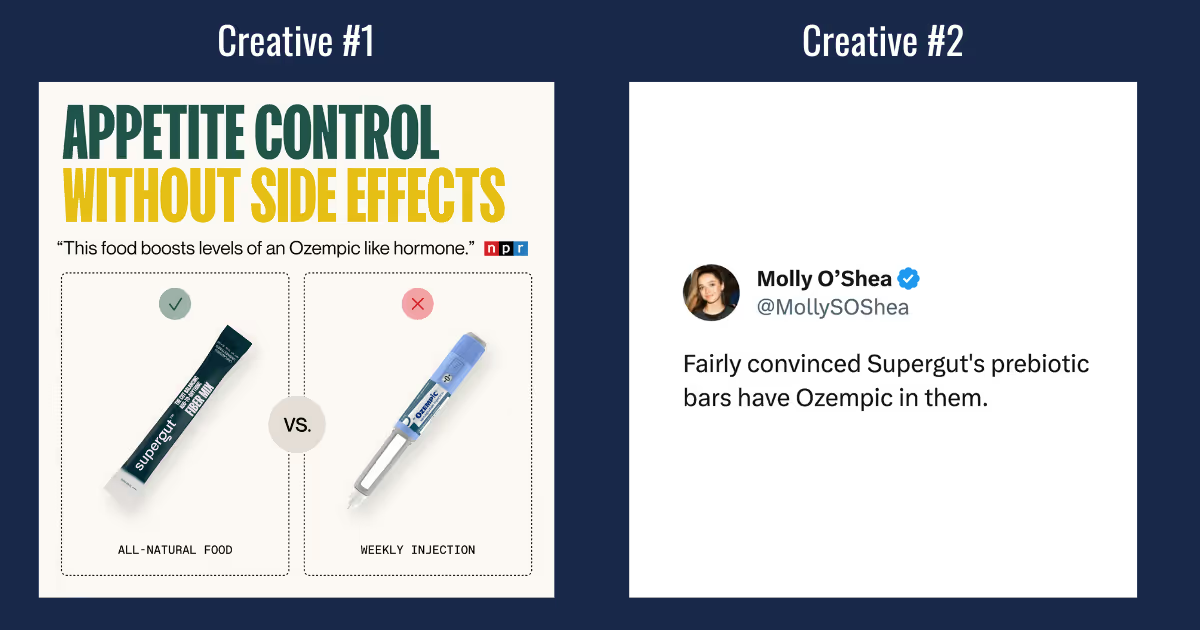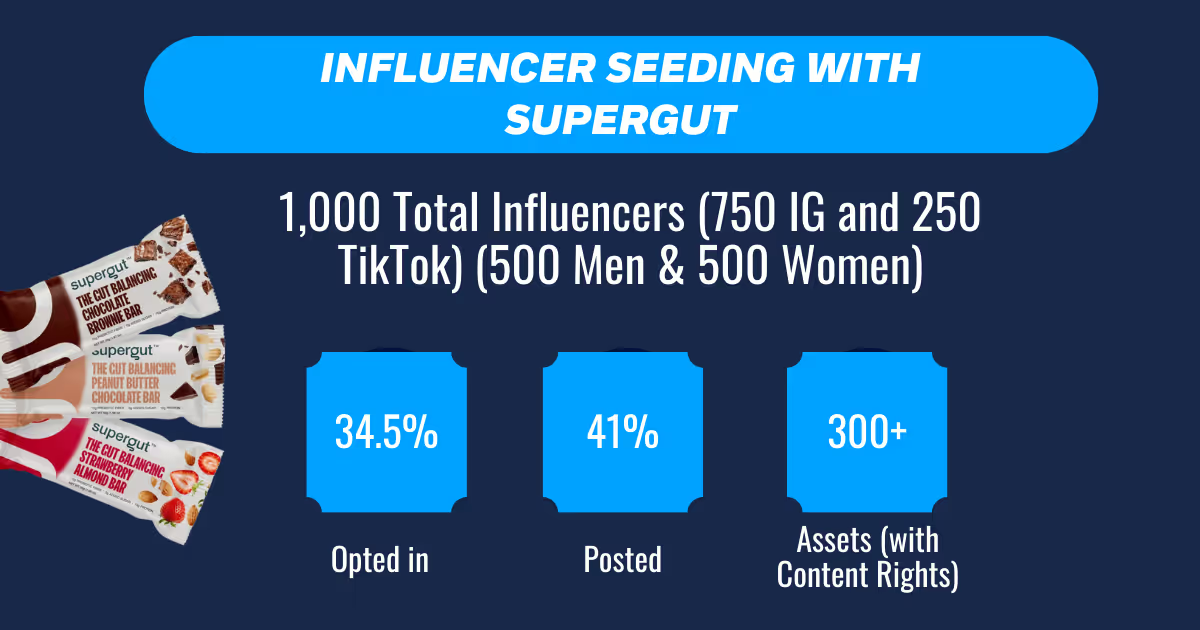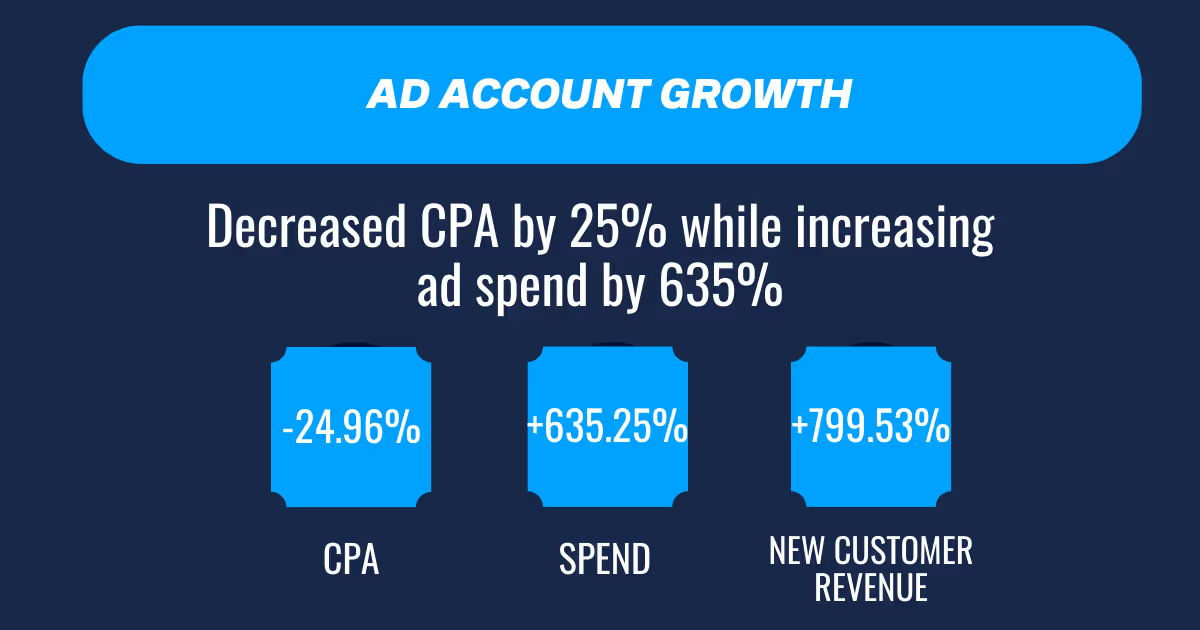
Supergut Achieves ‘Unprecedented' Revenue Growth with a 635% Increase in Ad Spend

Overview
Supergut sells gut health prebiotic bars, shakes, and fiber mix. Unlike probiotics or digestive enzymes, prebiotics are a lesser-known aspect of gut health. Supergut’s approach is science-based, validated by their own clinical study comparable to those conducted by pharmaceutical companies.
Supergut faced the challenge of capturing the limited attention and dollars of consumers who may not be aware of their gut health options. Seeding campaigns served as a strategic starting point, with the ultimate goal of generating as much high quality user-generated content (UGC). While the initial results of the seeding campaigns surpassed Kynship's internal benchmarks, Supergut's significant performance breakthrough came from a strategic shift in messaging.
By leveraging its brand creative, Supergut effectively distinguished its products from pharmaceutical alternatives such as Ozempic and Wegovy. This approach was designed to educate consumers about how Supergut's natural ingredients could enhance the GLP-1 gut hormone, similarly to how these drugs do, but through natural means. This refined messaging of branded creative, in combination with Kynship's meta advertising strategy, was the winning combo.
Top Performing Creative (Static)


“We’ve been working with Kynship for 6 months now and have been very happy with both the results and the seamless manner in which our teams collaborate. After hitting a performance plateau with our previous agency, over two quarters with Kynship we’ve been able to substantially cut and stabilize our Meta CPA, while concurrently increasing our ad budget many times over—driving unprecedented levels of revenue.”

Challenges
Supergut's challenge was twofold: escalating acquistion costs and the need to scale ad spend for new customer growth without sacrificing profitability. Their dependency on Meta for traffic and sales proved unsustainable, as reductions in ad spend failed to porportionately improve business performance. They had hit a performance plateau with their previous agency, relying on highest volume campaigns where spend was the only consistent variable and the efficiency of that spend changed constantly.
The desire to lessen Meta dependence—despite its role in brand awareness and site traffic—stemmed from erratic CPA trends and the realization that neither increasing nor reducing Meta spend achieved optimal customer acquisition cost efficiency. This situation was further complicated by Supergut's expansion onto Amazon, which, while boosting sales and lowering overall CAC, introduced challenges in sales attribution, diminishing the value of Meta spend.
This prompted Supergut to explore new directions, leading them to Kynship's integrated creative and media buying approach.
Solution
Supergut wanted to hold acquisition costs while raising ad spend in order to acquire more new customers. Kynship's approach was to implement an ad account strategy that integrated various types of content—internal brand creative, seeding, and UGC creative—all set within cost-controlled campaigns. This strategy was designed to maintain acquisition costs while creating more avenues of increased ad spend.
Influencer Seeding
Kynship identified and engaged 1,000 micro-influencers fitting Supergut's ideal influencer personas:
- Health optimizers and busy parents or professionals (but not people who are overly fitness/gym focused)
- Aspirational people who advocate a healthy, well-rounded lifestyle with an emphasis on diet and exercise in at least 25% of their content
- Men and Women in the age range of 25-40 living anywhere in the United States
As a rule of thumb for any Kynship client: All our influencers are micro influencers (5k-150k followers), have a minimum 1% engagement rate, active profile (posted in the last month), and quality video content abilities. Kynship reached out to 1,000 influencers, and 345 of them agreed to collaborate.
The campaign achieved a 34.5% opt-in rate which is significantly higher than Kynship's average rate of 20%. Out of those, 141 influencers went on to create content, which is a 41% post rate—above our average of 30%.
A total of 231 pieces of media were produced, including 188 Instagram Stories, 24 TikToks, 10 Instagram Feed Posts, and 9 Instagram Reels. After getting the rights to the content and making some edits, Supergut ended up with over 300 assets stored in Dropbox.
The initial seeding campaign successfully maximized creative diversity and volume for Supergut. However, it was the strategic refinement of the brand's messaging (primarily in branded creative), combined with Kynship's meta advertising strategy, that truly drove the highest performance.

Meta Ad Strategy
Leveraging the content generated from the influencer seeding campaign in combination with Supergut's branded creative, Kynship executed a Meta paid media strategy, utilizing Automated Shopping Campaigns (ASC) with cost cap campaigns per SKU. The targeting was broad, optimizing for a wide reach while maintaining cost efficiency. This strategy was aimed at increasing brand visibility, driving sales, and efficiently scaling ad spending.
Through testing hundreds of different assets, we found that Supergut's highest performing UGC assets were significantly outperformed by Supergut's brand creative.
Supergut experienced consistent growth from October to January. Kynship's strategy of increasing ad spend resulted in a substantial rise in revenue and new customer acquisitions. Despite the varying advertising efficiency, indicated by changes in the average marketing efficiency ratio (aMER), Supergut managed to enhance the effectiveness of its marketing efforts over time. The cost of acquiring a customer (CAC) saw fluctuations, initially rising then decreasing significantly, demonstrating improved cost-efficiency in their acquisition strategy.

Results
🔥 Revenue Growth: Supergut experienced significant revenue growth with ad spending substantially scaling up by 635.25%.
🔥 New Customer Acquisition: The number of new customer orders increased more than tenfold, with new customer revenue growing by 799.53%.
🔥 Efficiency Gains: The customer acquisition cost (CAC) was reduced by 24.96%, showcasing increased ad spend efficiency.
🔥 Amazon Sales: The increased Meta ad spend also had a positive ripple effect on Amazon sales, contributing to a 485.41% increase in revenue, demonstrating the strategy's broader impact on sales channels.

Lessons Learned & Future Plans
Key Takeaways
Implementing cost controls within an advertising account does not necessarily restrict spending. Instead, it provides a structured approach to manage expenditures efficiently while still enabling robust ad campaigns.
Supergut's highest performing UGC assets were significantly outperformed by its brand creative, demonstrating that it's not always the same formula of content (i.e UGC) needed to scale ad spend. It's about ensuring you have enough creative diversity and volume to test at scale, and iterate from there.
Next Steps
Continue to utilize diverse creative content, including branded materials, influencer seeding, and UGC in order to sustain and enhance Automated Shopping Campaigns (ASC) under a cost-controlled framework. By leveraging a variety of creative sources, Supergut can maintain the momentum of its advertising efforts, ensuring they remain both effective and economically viable.
“Kynship send us a thorough report every Monday morning ahead of our weekly call and stay highly responsive to our questions, guidance, and needs throughout the week. Their team members are experts in their domains—from media management to influencer seeding and the unique dynamics of running a DTC + Amazon business—and always conduct themselves in a professional and pleasant manner. We hope to continue our relationship with Kynship into the future and I would happily recommend their services to businesses similar to ours." —Farzad Sharif, Head of Marketing, Supergut
Why choose The Kynship System?









